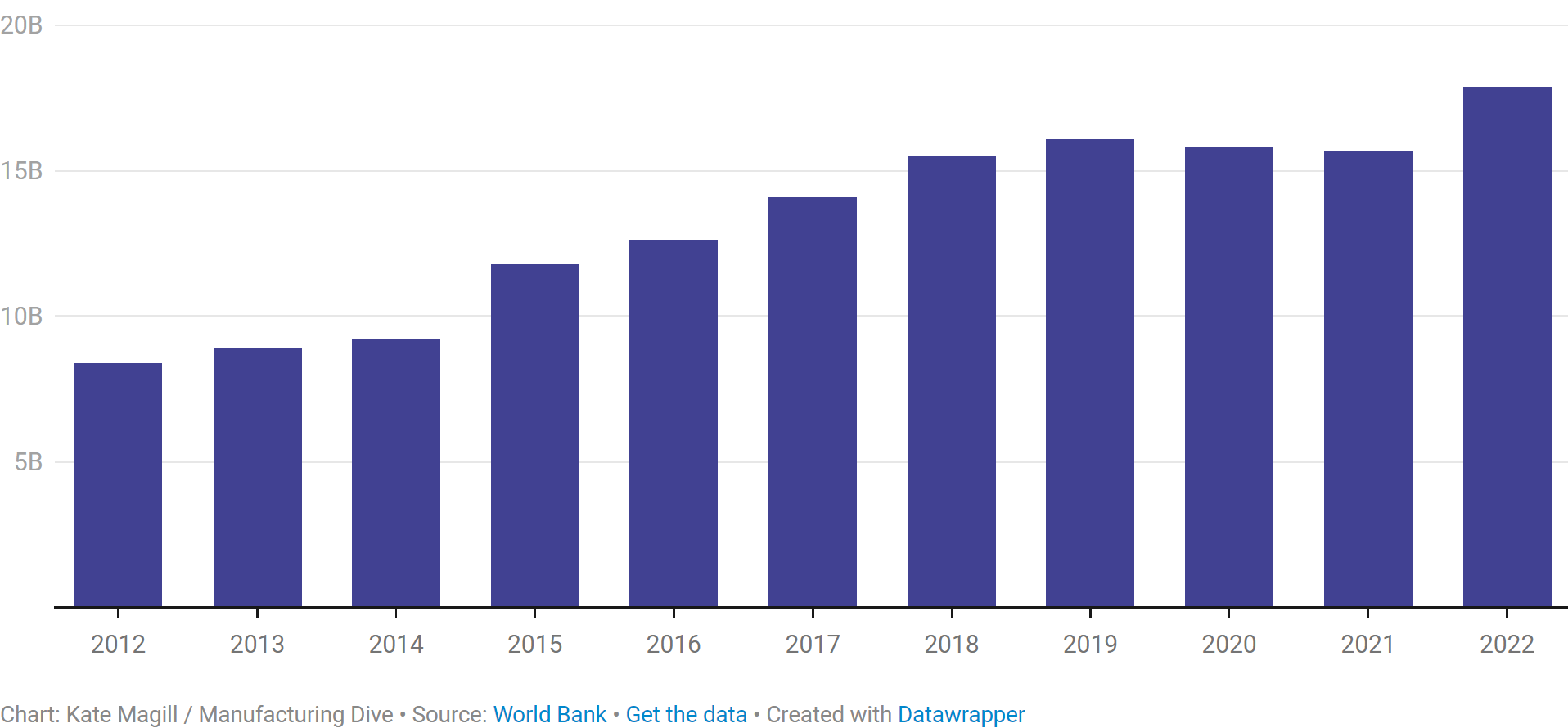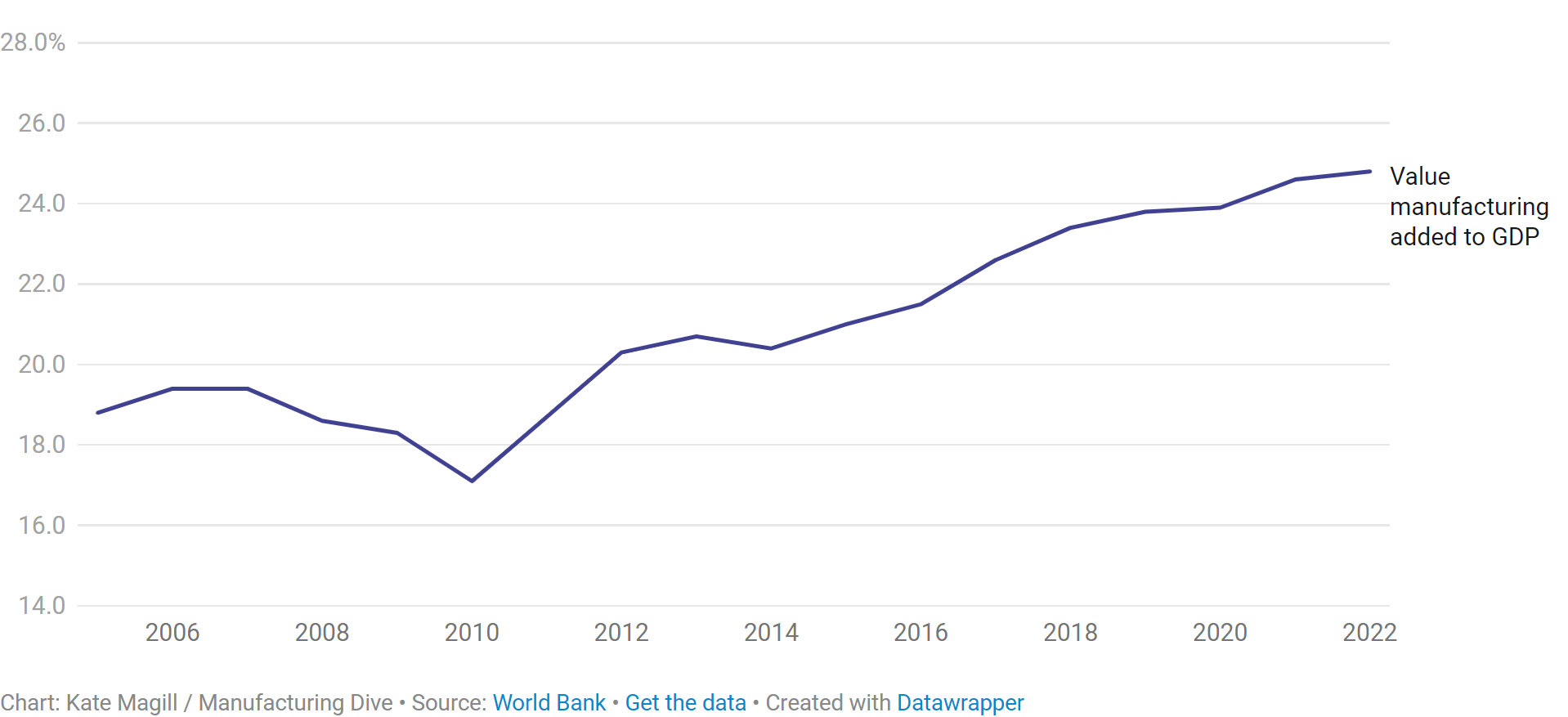
folder_open MagRabbit News
As manufacturers turn away from China, Vietnam lures investment
The country has become home to a growing number of factories thanks to its increased use of free trade agreements, tax incentives and competitive labor costs. Ho Chi Minh City is becoming home to a growing number of semiconductor companies, such as Marvell and Intel, as the country becomes a popular alternative to China for contract manufacturing.
When President Joe Biden gathered executives from Google, Amkor, Intel, Marvell, GlobalFoundries and Boeing to meet with Vietnamese Prime Minister Pham Minh Chính in September, it marked one of the most significant gatherings in recent years between the U.S. and Vietnam when it comes to trade relations.
China has long been a popular choice for contract production in Asia due to its extensive labor pool, raw material availability and established logistics ecosystem. But as trade relations between it and the U.S. continue to sour, companies and the Biden administration are looking elsewhere for friendlier business partners. Enter Vietnam.
Vietnam has put a premium on attracting semiconductor and advanced electronics manufacturing, bringing in some of the world’s biggest companies.
In October, chip packaging maker Amkor announced its first, $1.6 billion factory in Vietnam, slated to be the company’s largest facility to date. And in September 2022, Google announced plans to produce its Pixel smartphones in Vietnam in September 2022, while semiconductor developer Marvell announced in May it would establish a design center in Ho Chi Minh City.
In tandem with the U.S.-Vietnam business roundtable, in September the two countries signed a new strategic partnership — the highest tier of economic partnership Vietnam forges with other countries, according to the White House — dedicated to building a resilient semiconductor supply chain to support U.S. industry.
Foreign direct investment in Vietnam rose 54% year-on-year in October 2023, reaching $15.3 billion, according to data from the country’s Ministry of Planning and Investment. Investment in processing and manufacturing accounted for nearly 75% of the money.
“The U.S. is at a government level recognizing the growing importance of Vietnam as a manufacturing hub for U.S. multinationals,” said Asia-Pacific Chief Economist at S&P Global Market Intelligence Rajiv Biswas. “They want to tap into that capacity of Vietnam to be part of U.S. supply chains and electronics manufacturing.”
As U.S. manufacturers’ eyes turn towards the country, Vietnam is pushing to ensure its industry and economy are set up for long-term growth.
Vietnam’s rise to manufacturing prominence
The first major foreign semiconductor-related manufacturer to establish operations in Vietnam was Intel in 2010, when it opened a $1 billion chip assembly and test facility in Ho Chi Minh City. The opening of the factory illustrated the country’s advantages as a manufacturing base for others in the advanced electronics industry, Biswas said.
“Ever since then, what we’ve seen is that Vietnam has really gone from strength to strength in developing its electronics sector,” he noted.
Manufacturing is becoming increasingly valuable to Vietnam’s GDP
Percentage of value added to GDP by manufacturing, 2005-2022
 In the 13 years since Intel’s arrival, Vietnam has successfully pursued investment from global electronics leaders, like South Korea-based companies LG and Samsung, U.S. firms such as Amkor, and others. One of the keys to this success has been lucrative tax incentives for foreign investors.
In the 13 years since Intel’s arrival, Vietnam has successfully pursued investment from global electronics leaders, like South Korea-based companies LG and Samsung, U.S. firms such as Amkor, and others. One of the keys to this success has been lucrative tax incentives for foreign investors.
The country offers three main types of foreign investment incentives, related to corporate income tax, import duties and land rent. Vietnam has also established economic zones that “provide increased access to infrastructure, pools of talent, and networks of suppliers,” according to Vietnam Briefing.
The cost of labor in Vietnam also remains cheaper than in China: Vietnam’s labor costs are roughly $2.99 per hour compared to $6.50 per hour in China as of last year.
Finally, the country has leaned into free trade agreements, making it a more attractive trade partner for U.S. businesses with global supply chains. The country signed a free trade deal with the EU in 2019, an agreement with the UK in 2020 and joined the Comprehensive and Progressive Agreement for Trans-Pacific Partnership when it was created in 2018.
It’s also a member of the Association of Southeast Asian Nations alongside Brunei Darussalam, Myanmar, Cambodia, Indonesia, Laos, Malaysia, Philippines, Singapore and Thailand. The group is collectively the U.S.’s fourth largest trading partner.
“There’s been a lot of bilateral free trade agreements between ASEAN and other countries, which has helped to lower the tariff barriers for trade for Vietnam for imports and exports,” Biswas said. “Which is also very important for developing their export sector, as well as getting competitive import costs.”
The increase in U.S. reliance on Vietnam for goods in the last decade is clear. U.S. goods imports from Vietnam reached $127.5 billion in 2022, up 25.1% from 2021 and up a whopping 529% from 2012, according to the office of the U.S. Trade Representative.
Vietnam focuses on ‘supporting industries’
Vietnam has aggressive goals for its manufacturing growth. The country set a target for 30% of its GDP to come from manufacturing by 2030, growing the industry’s contribution by 8.5% a year, according to McKinsey.
Vietnamese officials are keenly aware of trying to ensure the state is creating a durable domestic sector that can support the country into the future, said Arrian Ebrahimi, author of the Chip Capitols newsletter and a former policy assistant at the Semiconductor Industry Association.
“Vietnam seems to be trying to take a similar path of development as Taiwan did a while back, where they start with lower value-add parts of the chip industry, and by attracting both investment and talent through those lower value added segments, slowly climb up the food chain,” Ebrahimi said.
The strategy aims to lay Vietnam’s foundation to host other industries down the road.
“They’re trying to take a long-term approach to their industry,” Ebrahimi said.
“They don’t want to just give out state dollars to any manufacturer that will come in and make jobs in Vietnam [and add] to the GDP short-term.”
Vietnam has been focused on growing its “supporting industries:” Companies that produce raw materials, components and spare parts used to assemble finished goods.
Doing so is meant to help elevate the country’s manufacturing capacity in key sectors such as semiconductors, electronics and automotive, according to Vietnam Briefing. In 2021, industrial parks in the country attracted $1.1 billion in supporting industry investments.
Foreign direct investment into Vietnam is on the rise
FDI net inflows to Vietnam, 2012-2022
 Vietnam has aggressive goals for its manufacturing growth. The country set a target for 30% of its GDP to come from manufacturing by 2030, growing the industry’s contribution by 8.5% a year, according to McKinsey.
Vietnam has aggressive goals for its manufacturing growth. The country set a target for 30% of its GDP to come from manufacturing by 2030, growing the industry’s contribution by 8.5% a year, according to McKinsey.
“Vietnam seems to be trying to take a similar path of development as Taiwan did a while back, where they start with lower value-add parts of the chip industry and by attracting both investment and talent through those lower value added segments, slowly climb up the food chain,
”Ebrahimi said. “Even if the company coming in is primarily a semiconductor upstream equipment or materials provider, they still want to know what other technologies down the road it would also support.”
“The U.S. is at a government level recognizing the growing importance of Vietnam as a manufacturing hub for U.S. multinationals.”
Rajiv Biswas
Asia-Pacific Chief Economist, S&P Global Market Intelligence
What does the future hold for Vietnam?
Vietnam is one of multiple countries that has benefited from a surge in shifting global supply chains, alongside the likes of Mexico and India. So where could the country see its manufacturing industry in the next several years?
“We do expect a very big increase in the size of the [Vietnamese] economy in the next 10 years,” Biswas said. “And what that means is the size of the domestic consumer market will grow quite substantially.”
As the domestic market grows, Biswas noted that more multinationals are likely to set up shop in the country to tap into not only its manufacturing sector but also to capture its consumer appetite. Vietnam’s GDP was $410 billion in 2022, and S&P Global Market Intelligence estimates it to grow to $750 billion by 2030.
And with its growing trade friendliness with the U.S., as well as a relatively stable economy, political landscape and labor wage market, the economist noted its relationship with foreign investors is likely to grow.
“I think more and more we’re going to see U.S. electronics firms at least establishing part of their supply chains in Vietnam as part of a diversified global supply chain system,” Biswas said. “There’s probably at least another 10 to 20 years of ability for Vietnam to compete in low cost manufacturing.”
Source: https://www.manufacturingdive.com/news/vietnam-manufacturing-semiconductors-hub-growth-us-biden-china-amkor-intel-google/702544/https://www.vico.com.hk/en/resource/news/a-complete-guide-of-moving-manufacturing-to-vietnam
